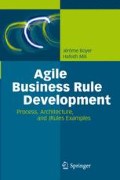Abstract
Target audience (Must) business analyst; (optional) project manager, application architect, rule author In this chapter you will learn What are the different types of rules, and why it is important to understand them How to set in place the rule harvesting process according to the source of rules and the team structure How to extract a data model for the rules from the rule description How to prepare the rules for implementation How to put into practice these techniques with a claim processing application Key points Start by a decision point that is simple but still brings business value to the stakeholders. Describe rules using the business domain vocabulary, and future map it to a logical data model.
Access this chapter
Tax calculation will be finalised at checkout
Purchases are for personal use only
Notes
- 1.
Business Motivation Model V 1.1 Object Management Group at http://www.omg.org/spec/BMM/1.1/.
- 2.
From Wikipedia, semantic web is defined as an extension to the WWW in which the meaning of information and services on the web is defined, making it possible for the web to “understand” and satisfy the requests of people and machines to use the web content.
- 3.
The term “rule discovery” roadmap is also used in the industry to present the journey the analysts go through.
- 4.
A business rule is said to be “atomic” in that it cannot be broken down or decomposed further into more detailed business rules. If reduced any further, there would be loss of important information about the business (Source: http://www. businessrulesgroup.org/first_paper/br01c3.htm).
- 5.
A conceptual data model defines the meaning of the things in an organization and includes business entities and their associations.
- 6.
References
Barbara von Halle, Business Rules Applied, John Wiley & Sons, 2001, ISBN 0-471-41293-7
Tony Morgan, Business Rules and Information Systems: Aligning IT with Business Goals, Addison-Wesley, 2002, ISBN 0-201-74391-4
James Taylor, and Neil Raden, Smart Enough Systems: How to Deliver Competitive Advantage by Automating Hidden Decisions Prentice Hall (2007)
Author information
Authors and Affiliations
Corresponding author
Rights and permissions
Copyright information
© 2011 Springer-Verlag Berlin Heidelberg
About this chapter
Cite this chapter
Boyer, J., Mili, H. (2011). Rule Harvesting. In: Agile Business Rule Development. Springer, Berlin, Heidelberg. https://doi.org/10.1007/978-3-642-19041-4_4
Download citation
DOI: https://doi.org/10.1007/978-3-642-19041-4_4
Published:
Publisher Name: Springer, Berlin, Heidelberg
Print ISBN: 978-3-642-19040-7
Online ISBN: 978-3-642-19041-4
eBook Packages: Business and EconomicsBusiness and Management (R0)

